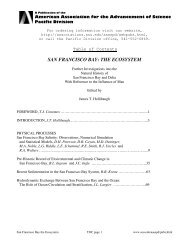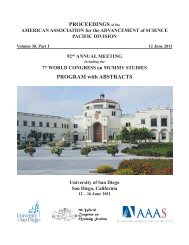Vol 31, Part I - forums.sou.edu ⢠Index page - Southern Oregon ...
Vol 31, Part I - forums.sou.edu ⢠Index page - Southern Oregon ...
Vol 31, Part I - forums.sou.edu ⢠Index page - Southern Oregon ...
You also want an ePaper? Increase the reach of your titles
YUMPU automatically turns print PDFs into web optimized ePapers that Google loves.
ABSTRACTS – Symposia<br />
Ciliates are single celled organisms hosting two types of<br />
nuclei, one an encrypted version of the other. In some species<br />
this encryption is nontrivial. During certain events in the<br />
ciliate life-cycle nuclei are updated through a process that<br />
involves decryption of the encrypted version. Mathematical<br />
models for the decryption process postulate certain specific<br />
molecular computations that achieve this decryption. In this<br />
work we seek to: (1) determine the molecular computational<br />
steps taking place during decryption by examining<br />
intermediate DNA products of the process; (2) determine the<br />
elements of the symmetric group that are invertible by the<br />
ciliate decryption apparatus; (3) determine the computational<br />
complexity of the several steps to be taken in modeling<br />
elements and operations of symmetric groups in the ciliate<br />
computing environment.<br />
All four authors contributed equally under the mentorship of Prof. Marion<br />
Scheepers, Boise State University. We acknowledge NSF grant DMS<br />
1062857 and Boise State University for supporting this work.<br />
35 Exploring Phylogenetic Relationships in Drosophila<br />
with Ciliate Operations, MARION SCHEEPERS 1 , ANNA<br />
NELSON 1 *, and JACOB HERLIN 2 . ( 1 Department of<br />
Mathematics, Boise State University, 1910 University Drive,<br />
Boise, ID 83725; 2 Department of Mathematical Sciences,<br />
University of Northern Colorado, 2901 South 27th Avenue,<br />
Greeley, CO 806<strong>31</strong>; annanelson1@u.boisestate.<strong>edu</strong>).<br />
Phylogenetics is the study of evolutionary relationships<br />
among groups of organisms. It is known that the genomes<br />
of some species are related by permutations of gene locations<br />
on chromosomes. The central research question that<br />
arises from this finding is to find mathematical operations<br />
on permutations that most faithfully model the evolutionary<br />
steps by which genome rearrangements arise. Classical work<br />
on the question hypothesize that genome rearrangements<br />
arise through reversals only. Data about the developmental<br />
genome remodeling events in ciliates suggest that there are<br />
additional genome rearrangement operations that could also<br />
be routinely involved in the evolutionary process. Ciliates<br />
are capable of permuting DNA segments using merge, swap,<br />
and reverse operations. We created a deterministic algorithm<br />
that simulates permuting DNA sequences using these three<br />
ciliate operations. It determines in polynomial time evolutionary<br />
distances among scrambled genomes. After implementing<br />
our algorithm in Python we applied it to extensive<br />
data about genome rearrangements in fruit-fly species. We<br />
found a correlation between the published evolutionary distances<br />
of the fly species, found by other means by others, and<br />
the number of ciliate reversal operations used by our algorithm.<br />
For all but one of the eight species we found this correlation<br />
also held for the total number of uses of the reversal<br />
and swap operations used. Our research was supported by<br />
the NSF Mathematics REU site grant DMS 1062857 and by<br />
Boise State University.<br />
36 Geometry, Topology, and Complexity of Virtual Knots,<br />
ASHLEY EARLS 1 *, GABRIEL ISLAMBOULI 2 *, and<br />
RACHAEL KELLER 3 * ( 1 Department of Mathematics, St<br />
Olaf College, 1500 St. Olaf Ave, Northfield, MN 55057,<br />
earls@stolaf.<strong>edu</strong>; 2 Department of Mathematics, University<br />
of Virginia, Charlottesville, VA 22904, gfi8ps@virginia.<strong>edu</strong>;<br />
3<br />
Department of Mathematics, Louisiana State University,<br />
Baton Rouge, LA 70803, rkell18@tigers.lsu.<strong>edu</strong>).<br />
Knots, strings tangled in 3-space, are objects with which<br />
everyone is familiar. The mathematical theory of knots is<br />
highly sophisticated, incorporating many classical areas<br />
including topology, geometry, combinatorics and group theory.<br />
Currently, the study of knots is finding application in<br />
fields as diverse as biology, physics and computing.<br />
A knot, when drawn on a piece of paper, is a planar<br />
4-regular graph. A virtual knot, from a graph theoretic point<br />
of view, is an arbitrary (not necessarily planar) 4-regular<br />
graph. Many questions which have been answered for classical<br />
knots are still unanswered for virtual knots. In our talk<br />
we will introduce virtual knots and explain their relevance to<br />
long standing conjectures, such as Whitehead’s asphericity<br />
conjecture.<br />
All three authors contributed equally under the mentorship of Prof. Jens<br />
Harlander, Boise State University. We acknowledge NSF grant DMS<br />
1062857 and Boise State University for supporting this work.<br />
Responses of Sagebrush-Steppe<br />
Ecosystems to a Changing Climate<br />
Monday, 1:30 p.m. in SALMON RIVER<br />
37 Changes in Soil Aggregate Dynamics and Carbon Storage<br />
Following 18 Years of Experimentally Increased Precipitation<br />
in a Cold Desert Ecosystem, MARIE-ANNE de<br />
GRAAFF 1 *, JESS van der VEEN 2 , MATTHEW GER-<br />
MINO 2 , and JAMIE HICKS 1 ( 1 Department of Biological<br />
Sciences, Boise State University, Boise, ID 38725; 2 USGS<br />
Forest and Rangeland Ecosystem Science Center, Boise, ID<br />
83706; marie-annedegraaff@boisestate.<strong>edu</strong>).<br />
Climate change is expected to alter the amount and<br />
timing of precipitation in semi-arid ecosystems of the Intermountain<br />
West, and the net effect of these changes on soil<br />
C sequestration is not well understood. Soil C sequestration<br />
is regulated by the incorporation of C into soil aggregates,<br />
where they are physically protected from microbial degradation.<br />
With this study we assessed: (1) how precipitation<br />
shifts affect soil aggregate formation and associated soil<br />
organic carbon (SOC) contents in semi arid ecosystems,<br />
and (2) how plants mediate precipitation impacts on soil<br />
C sequestration. Soil was collected from an ecohydrology<br />
study situated at INL. The experimental field site consists<br />
of subplots planted with either sagebrush (Artemisia tridentata)<br />
or crested wheatgrass (Agropyron cristatum) and<br />
has been exposed to three precipitation treatments: ambient<br />
(i.e.control), winter (200mm) or summer (4x50mm) for 18<br />
57








